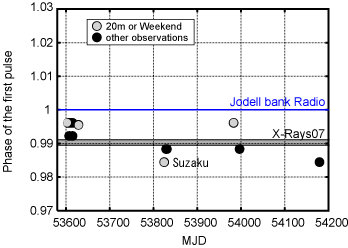HXD: Timing accuracy
Calibration status
- Relative timing
As shown in figure 1, the HXD has detected periodic signals from several pulsars after the barycentric corrections, both with PIN and GSO. The pulse periods of Crab pulsar on over 23 observations agree with those measured by Jodrell Bank Radio observatory within 1.0 ns (this error mainly arise from duration of an observation and statistics of signals), as shown in figure 2. The main pulses of these Crab observations stay within 0.005 phases during an observation, implying the stability of arrival time measurements is within 1.9 x 10-9.

Figure 1: Periodograms and pulse profiles of A0535+262, Hercules X-1, PSR1509-58, and the Crab pulsar, observed with the HXD. Left panels show the periodograms, obtained by PIN in the 10--70 keV band. Middile and right panels show pulse profiles by PIN and GSO, respectively.

Figure 2: Pulsation periods of the Crab pulsar obtained by the HXD, compared with the radio measurements at the Jodrell Bank observatory. The residuals are shown in the bottom panel.
- Absolute timing
According to a simultaneous observation of Crab with other X-ray missions, RXTE, INTEGRAL, and Swift on 2007 March 20-21, the absolute timing of the main pulse of Crab with the HXD agree with other instruments within 160 micro s, as shown in figure 3. Among 23 observations of Crab with Suzaku, the main pulse phase scatters by about 0.010 ± 0.005 phases (with 90% err), which corresponding to 360 ± 150 micro s. This value becomes better as 270 ± 130 micro s, if we select datasets which were operated with 34m antenna system on a week day.

Figure 3: X-ray pulse-profiles of the Crab pulsar obtained by the Suzaku HXD PIN (10--70 keV), the RXTE PCA (2--30 keV), the HEXTE (20--100 keV), the INTEGRAL IBIS ISGRI (20--100 keV), and the Swift BAT (15--350 keV) from top to bottom. The phase 0 corresponds to the arrival time of the first pulse obtained by the Jodrell Bank Radio observatory.

Figure 4: Phases of the first pulse of Crab obtained by HXD PIN, compared to the Jodell Bank ephemeris. Phase 0.0 corresponds to the barycentric arrival time of the radio pulses determined by the Jodell Bank observatory, and the Suzaku data are shown in circles (Filled circles was taken with the 34m system on working days, and open-gray circles presents other conditions, 20m system or weekend.). The phases tagged as ``X-ray 07'' are determined by the simultaneous observation on 2007 May in Figure 3.
Related links
- Suzaku memo 2006-36 "The Hard X-ray Detector(HXD) on Board Suzaku"
- Suzaku memo 2006-37 "In-Orbit Performance of the Hard X-ray Detector onboard Suzaku"
Last Modified: 04-July-2007





